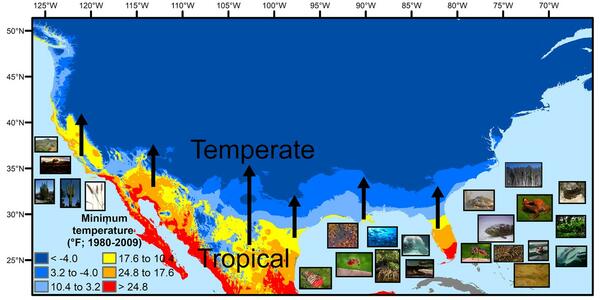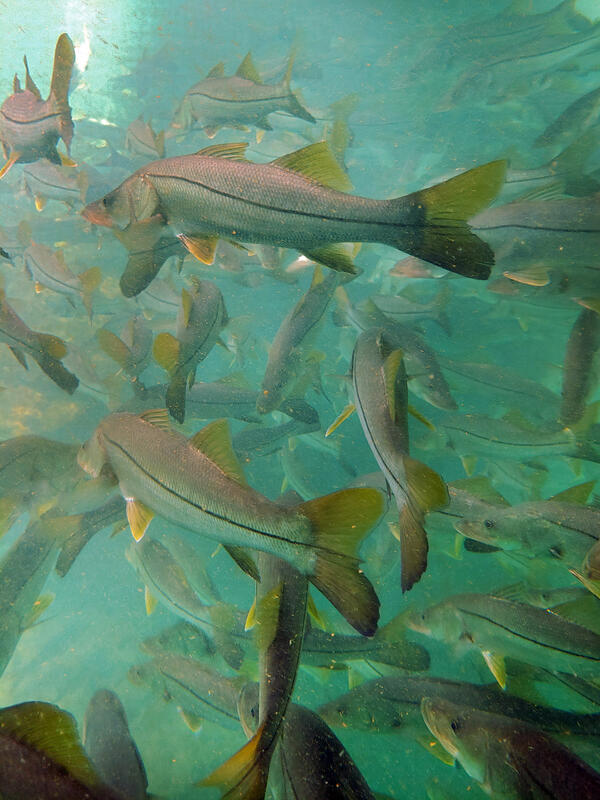An environmental DNA (eDNA) sampler discretely placed among streamside vegetation at the Flying D Ranch in Montana. An arrow is superimposed on the image to point out the eDNA sampler.
Images
See our science through the images below.

An environmental DNA (eDNA) sampler discretely placed among streamside vegetation at the Flying D Ranch in Montana. An arrow is superimposed on the image to point out the eDNA sampler.
An environmental DNA (eDNA) sampler discretely placed among the vegetation along a stream on the Flying D Ranch in Montana.
An environmental DNA (eDNA) sampler discretely placed among the vegetation along a stream on the Flying D Ranch in Montana.

USGS scientists operate drones with particulate and gas samplers over a prescribed burn in Kansas.
linkJoe Adams (USGS National Uncrewed Systems Office) pilots and Keith Grabner (USGS Columbia Environmental Research Center) acts as visual observer as a drone equipped with EPA particulate and gas samplers (right) hovers in the plume of a spring prescribed burn at the Konza Prairie Biological Station, Tallgrass Prairie National Preserve, Kansas.
USGS scientists operate drones with particulate and gas samplers over a prescribed burn in Kansas.
linkJoe Adams (USGS National Uncrewed Systems Office) pilots and Keith Grabner (USGS Columbia Environmental Research Center) acts as visual observer as a drone equipped with EPA particulate and gas samplers (right) hovers in the plume of a spring prescribed burn at the Konza Prairie Biological Station, Tallgrass Prairie National Preserve, Kansas.
Blackfoot & Jackson Glaciers: 8/1/1914 EC Stebinger, USGS Photographic Library – 9/3/2009 L McKeon, USGS
Since the historic photo was taken, Blackfoot Glacier has retreated and fragmented into two separate glaciers, Blackfoot (foreground) and Jackson (distant) Glaciers.
Blackfoot & Jackson Glaciers: 8/1/1914 EC Stebinger, USGS Photographic Library – 9/3/2009 L McKeon, USGS
Since the historic photo was taken, Blackfoot Glacier has retreated and fragmented into two separate glaciers, Blackfoot (foreground) and Jackson (distant) Glaciers.
Boulder Glacier in 1910 (Elrod photo, GNP Archives) and in 2007 (Fagre/Pederson photo, USGS). Matching the intersection of the peaks in the background helps the repeat photographer locate the photo point. USGS Public domain
Boulder Glacier in 1910 (Elrod photo, GNP Archives) and in 2007 (Fagre/Pederson photo, USGS). Matching the intersection of the peaks in the background helps the repeat photographer locate the photo point. USGS Public domain
Grinnell, Gem & Salamander Glaciers: 8/9/1910 M Elrod, U of M Library – 9/27/2016 L McKeon, USGS
View the full collection at USGS Photographic Library
Grinnell, Gem & Salamander Glaciers: 8/9/1910 M Elrod, U of M Library – 9/27/2016 L McKeon, USGS
View the full collection at USGS Photographic Library

United States map of modeling results showing the probability of arsenic greater than 5 micrograms per liter. Map of sink and faucet superimposed upon it.
linkUnited States map showing modeling results (red) of the probability of arsenic concentrations greater than 5 micrograms per liter. Map of sink and faucet superimposed upon it.
United States map of modeling results showing the probability of arsenic greater than 5 micrograms per liter. Map of sink and faucet superimposed upon it.
linkUnited States map showing modeling results (red) of the probability of arsenic concentrations greater than 5 micrograms per liter. Map of sink and faucet superimposed upon it.

A map showing North America's tropical-to-temperate transition zone. Red, orange, and yellow depict the more tropical zones, and blues depict the more temperate zones, based on to the coldest recorded temperature for each area between 1980 and 2009.
A map showing North America's tropical-to-temperate transition zone. Red, orange, and yellow depict the more tropical zones, and blues depict the more temperate zones, based on to the coldest recorded temperature for each area between 1980 and 2009.

Winter temperature extremes control the distributions of subtropical fishes. Common snook (Centropomus undecimalis), aggregate at a spring in northern Florida during winter. Snook are warm saltwater game fish, common in Florida, that have been moving further northward as extreme cold spells become less frequent and less intense.
Winter temperature extremes control the distributions of subtropical fishes. Common snook (Centropomus undecimalis), aggregate at a spring in northern Florida during winter. Snook are warm saltwater game fish, common in Florida, that have been moving further northward as extreme cold spells become less frequent and less intense.
Agassiz Glacier: 8/5/1913 WC Alden, USGS Photographic Library - 8/24/2007, D Fagre, USGS
View the full collection at USGS Photographic Library
Agassiz Glacier: 8/5/1913 WC Alden, USGS Photographic Library - 8/24/2007, D Fagre, USGS
View the full collection at USGS Photographic Library
Repeat photo of Harrison Glacier. 8/20/1913 by WC Alden, USGS Photographic Library, 7/30/2009 by Ralph Thornton, USGS.
Repeat photo of Harrison Glacier. 8/20/1913 by WC Alden, USGS Photographic Library, 7/30/2009 by Ralph Thornton, USGS.
Karen Holzer and Lisa McKeon rephotograph Shepard Glacier from the slope of Pyramid Peak, Glacier National Park. 1998 USGS photo.
Karen Holzer and Lisa McKeon rephotograph Shepard Glacier from the slope of Pyramid Peak, Glacier National Park. 1998 USGS photo.
Chaney Glacier: 1911, MR Campbell, USGS Photographic Library – 8/19/2005 Karen Milone, USGS
View the full collection at USGS Photographic Library
Chaney Glacier: 1911, MR Campbell, USGS Photographic Library – 8/19/2005 Karen Milone, USGS
View the full collection at USGS Photographic Library
Boulder Glacier Ice Cave: 1932, TJ Hileman, GNP Archives – 1988, J DeSanto, U of M Library
This photo pair inspired the USGS to document glacier and landscape change using oblique photography.
Boulder Glacier Ice Cave: 1932, TJ Hileman, GNP Archives – 1988, J DeSanto, U of M Library
This photo pair inspired the USGS to document glacier and landscape change using oblique photography.
Shepard Glacier: 9/6/1913, WC Alden, USGS Photo Library – 8/21/2005, B. Reardon, USGS
Shepard Glacier: 9/6/1913, WC Alden, USGS Photo Library – 8/21/2005, B. Reardon, USGS
Sperry Glacier: circa 1930, MJ Elrod, U of M Library – 9/17/2008, L McKeon, USGS
Repeating this photo from the same photo point was impossible since the historic photo was shot from the elevated perspective of the glacier’s surface.
Sperry Glacier: circa 1930, MJ Elrod, U of M Library – 9/17/2008, L McKeon, USGS
Repeating this photo from the same photo point was impossible since the historic photo was shot from the elevated perspective of the glacier’s surface.
Grinnell Glacier in 1910 (Elrod photo, U of M Collection) and 2016 (McKeon photo, USGS). Retreat resulted in glacier fragmentation, so the 2016 scene shows both Grinnell Glacier, hugging the base of the cliff, and The Salamander Glacier, perched above, along the right edge of the photograph.
Grinnell Glacier in 1910 (Elrod photo, U of M Collection) and 2016 (McKeon photo, USGS). Retreat resulted in glacier fragmentation, so the 2016 scene shows both Grinnell Glacier, hugging the base of the cliff, and The Salamander Glacier, perched above, along the right edge of the photograph.
Grinnell and The Salamander Glaciers from the summit of Mt. Gould: 1938, TJ Hileman, GNP Archives – 9/4/2019, L McKeon, USGS
Upper Grinnell Lake has formed as the glacier has retreated. The change in height of Grinnell Glacier along the cliff face hints at volume loss during this timespan.
Grinnell and The Salamander Glaciers from the summit of Mt. Gould: 1938, TJ Hileman, GNP Archives – 9/4/2019, L McKeon, USGS
Upper Grinnell Lake has formed as the glacier has retreated. The change in height of Grinnell Glacier along the cliff face hints at volume loss during this timespan.
Swiftcurrent Glacier: circa 1910, M. Elod, GNP Archives - 9/27/2016, L McKeon, USGS
During the timespan between these photos, it is evident that Swiftcurrent Glacier has retreated and wildfire has consumed a patch of trees at the base of Swiftcurrent Mountain, the broad, beige slope in the background.
Swiftcurrent Glacier: circa 1910, M. Elod, GNP Archives - 9/27/2016, L McKeon, USGS
During the timespan between these photos, it is evident that Swiftcurrent Glacier has retreated and wildfire has consumed a patch of trees at the base of Swiftcurrent Mountain, the broad, beige slope in the background.
Logan and Red Eagle Glaciers: Aug. 1914, EC Stebinger, USGS Photo Library – 9/2/2009, L McKeon, USGS
These glaciers were once a continuous glacier, but became separate glaciers as retreat progressed.
Logan and Red Eagle Glaciers: Aug. 1914, EC Stebinger, USGS Photo Library – 9/2/2009, L McKeon, USGS
These glaciers were once a continuous glacier, but became separate glaciers as retreat progressed.
Jackson Glacier: 1912, MJ Elrod, U of M Library – 9/3/2009, L McKeon, USGS
Trees and vegetation continue to establish themselves at the base of Jackson Glacier as the glacier retreats.
Jackson Glacier: 1912, MJ Elrod, U of M Library – 9/3/2009, L McKeon, USGS
Trees and vegetation continue to establish themselves at the base of Jackson Glacier as the glacier retreats.

















